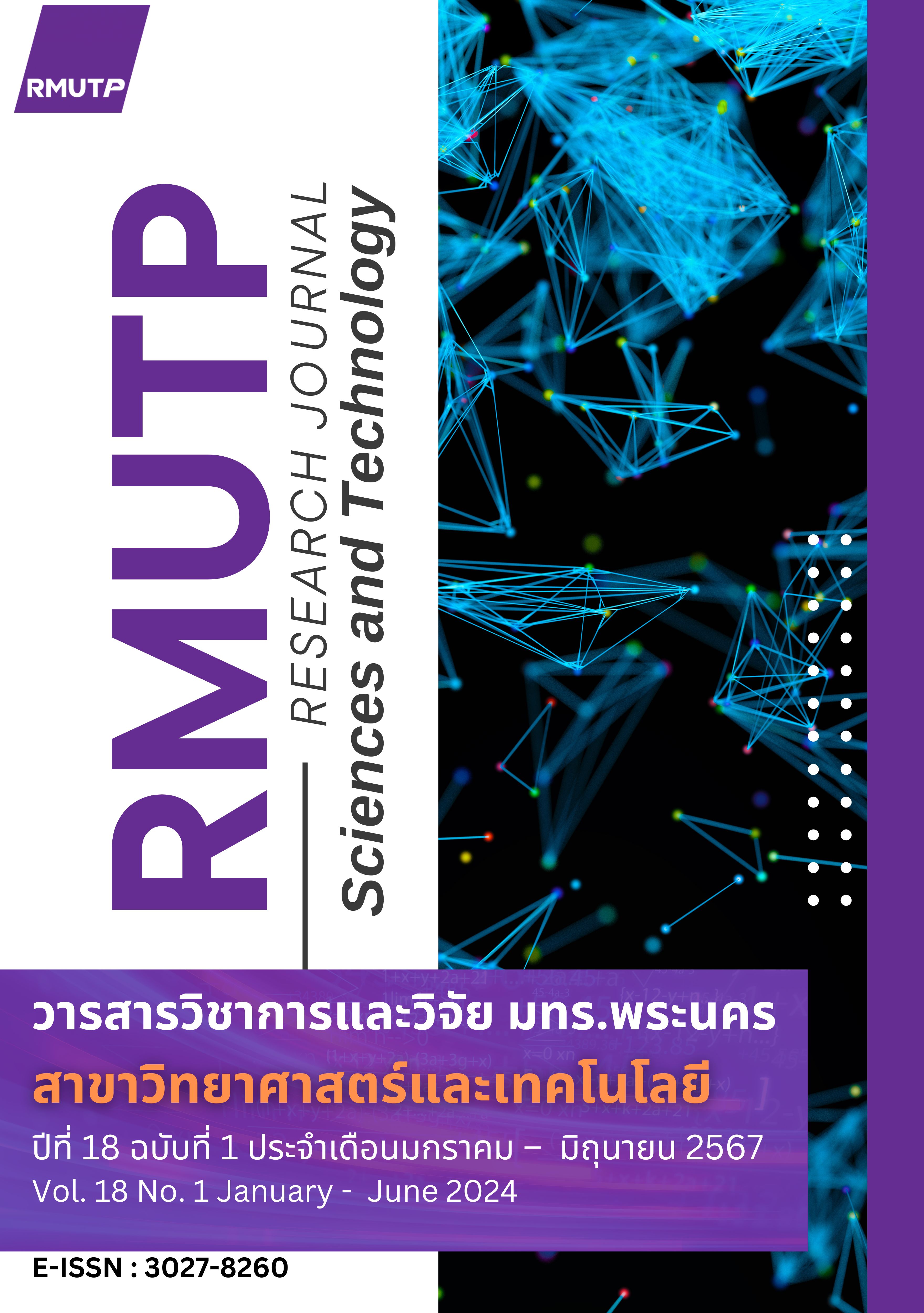อิทธิพลของอัตราการให้น้ำต่อผลผลิตและคุณภาพหญ้าเนเปียร์ปากช่อง 1 โดยใช้เครื่องรับรู้สำหรับตรวจวัดค่าความชื้นในดิน
Main Article Content
บทคัดย่อ
งานวิจัยนี้ศึกษาอัตราการให้น้ำต่อผลผลิตและคุณภาพหญ้าเนเปียร์ปากช่อง 1 ได้แก่ น้ำหนักสด น้ำหนักแห้ง และโปรตีนหยาบ ด้วยการทดลองแบบสุ่มสมบูรณ์ภายในบล็อก อัตราการให้น้ำในแต่ละแปลงด้วยเครื่องรับรู้สำหรับตรวจวัดค่าความชื้นในดิน จำนวน 3 ระดับ คือ 12 16 และ 20 ลูกบาศก์เมตรต่อไร่ต่อครั้ง วัดผลผลิตและคุณภาพโดยตัดหญ้าเนเปียร์ จำนวน 3 ครั้ง ครั้งที่ 1 อายุ 70 วัน ครั้งที่ 2 อายุ 115 วัน และครั้งที่ 3 อายุ 150 วัน พบว่า การตัดครั้งที่ 1 ผลผลิตไม่แตกต่างกันอย่างมีนัยสำคัญทางสถิติ (P > 0.05) น้ำหนักสด 4,190+403 4,019+435 และ 3,995+320 กิโลกรัมต่อไร่ น้ำหนักแห้ง 779+109 746+86 และ 734+64 กิโลกรัมต่อไร่ และค่าโปรตีนหยาบ ร้อยละ 10.88+1.02 10.73+0.83 และ 10.08+0.98 ของวัตถุแห้ง มีการให้น้ำ จำนวน 6 ครั้งต่อแปลง การตัดครั้งที่ 2 ผลผลิตไม่แตกต่างกันอย่างมีนัยสำคัญทางสถิติ (P > 0.05) น้ำหนักสด 7,075+618 6,924+511 และ 6,837+511 กิโลกรัมต่อไร่ น้ำหนักแห้ง 1,085+64 1,037+123 และ 1,036+37 กิโลกรัมต่อไร่ และโปรตีนหยาบ ร้อยละ 12.91+1.54 12.88+1.33 และ 12.86+1.19 ของวัตถุแห้ง มีการให้น้ำ จำนวน 3 ครั้งต่อแปลง และการตัดครั้งที่ 3 ได้ผลผลิตใกล้เคียงกับการตัดครั้งที่ 2 ผลผลิตและคุณภาพไม่แตกต่างกันอย่างมีนัยสำคัญทางสถิติ (P > 0.05) น้ำหนักสด 7,590+691 7,446+555 และ 7,456+788 กิโลกรัมต่อไร่ น้ำหนักแห้ง 1,138+162 1,161+166 และ 1,112+108 กิโลกรัมต่อไร่ และค่าโปรตีนหยาบ ร้อยละ 12.98+1.55 12.95+1.58 และ 12.94+1.08 ของวัตถุแห้ง มีการให้น้ำ จำนวน 5 ครั้งต่อแปลง ผลการศึกษานี้ สรุปได้ว่าอัตราการให้น้ำที่เหมาะสมต่อการเติบโต คือ 12 ลูกบาศก์เมตรต่อไร่ต่อครั้ง
Article Details

This work is licensed under a Creative Commons Attribution-NonCommercial-NoDerivatives 4.0 International License.
ลิขสิทธ์ ของมหาวิทยาลัยเทคโนโลยีราชมงคลพระนครReferences
C. Sowcharoensuk. (2020,Feb 7) Ri-drought .[Online]. Available: https://www.krungsri.com/th/research/research-intelligence/RI-Drought
Bureau of animal nutrition department. (n.d).Planting Napier Pak Chong 1 (5/2017). [Online]. Available:http://secretary.dld.go. th/index.php/informationdld/article-dld/2625-1-5-2560
Office of the secretary, Department of livestock development.(19 Oct 2020) Planting grass for livestock have a good income (1/2021) [Online]. Available:https://secretary.dld.go.th/webnew/index.php/th/news-menu/dld-editorial-menu/6799-1-2564
K. Kiyothong. (n.d). Handbook of Planting Napier Pak Chong 1 . [Online]. Available: http://extension.dld.go.th/th1/ images/stories/cattle_buff_bord/napiagrass.pdf
S. Udchachon. (n.d). How to planning napier in high production and good quality.[Online].Available:http://nutrition.dld.go.th/Nutrition_Knowlage/ARTICLE/72_1.HTML
N. Puengpa and A. Boontham. (n.d). Study on the Optimun Quantity of Irrgation Water Application for Different Stages of Sugarcane Growth. The 9 th Kasetsart University Kamphaeng Saen Campus Conference. [Online].Available:: http://researchconference.kps.ku.ac.th/article_9/pdf/p_plant12.pdf
Handbook of Planting Napier Pak Chong 1, 1st Ed., Nakhon Ratchasima : Mittrapap Printing, 2013.
S. Mongkolpitak and T. Suesut.(2015). Environment Monitoring And Control For Agriculture Via Smart Device. The 54 th Kasetsart University Conference. [Online]. Available: https://agkb.lib.ku.ac.th/ku/search_ _detail/dowload_digital_file/334101/91338
N. Đuzić and D. Đumić. , “Automatic Plant Watering System via Soil Moisture Sensing by means of Suitable Electronics and its Applications for Anthropological and Medical Purposes”, Collegium antropologicum, June 41(2): 169-172,2017.
N. Pourphan and O. Koaykitjarern, “Evaluation of Effectiveness on Border Irrigation for Napier Grass”, B.Eng. Project, Dept. Civil Eng, Kasetsart Univ. Kamphaengsaen Campus., Nakhon Pathom, 2013.
S. Wijitphan and P. Lowilai, “Effects of Cutting Interval on Yields and Nutritive Values of King Napier Grass (Pennisetum purpureum cv. King grass) under Irrigation Supply,” KKU Research Journal, vol. 16(3), pp. 215–224, Mar. 2011.
P. Kulasuwan, P. Thobunluepop, N. Tonmukayakul, P. Mani-in, A. Pongtip, J.Muangpan, J. Changkaewmanee and N. Vinijchevit, “Effect of Seassonal and Cutting Interval of Napier Paek-Chong 1 on Growth Biomass and Biogas Productivity”, Agricultural Science Journal, Vol.45 No.2 (Suppl.) May-August, pp. 721-724 ,2014.
S. Moonsrikaew, D. Chittathanaseshth, N. Khajornchaikul, A. Phumivithcha and S. Krangwong, “The effect of manure fertilizer on yield and nutritive values of hybrid napier grass (Pennisetum purpureum x Pennisetum Americanum, Pak Chong1),” in Proceeding of 1st , Faculty of Agricultural Technology and Agro-Industr, Rajamangala University of Technology Suvarnabhumi, 2016, pp.1-7.
AOAC., “Official method of analysis”, (21th) Association of Official Analytical Chemistry, Washington D.C.: USA.,1984.
V.M. Ngo and H. Wiktorsson, “Forage yield, nutritive value, feed intake and digestibility of three grass species as affected by harvest frequency”, Trop. Grasslands. 37: 101-110, 2003.
J. Noola-aong, A. Poh-etae and I. Aleemama, “Effect of Fertilizer on Yield and Chemical Compositions of Napier Grass (Pennisetumpurpureum)”, YRU Journal of Science and Technology , Vol. 1 No. 2 ,pp 23-30, 2016.
S. A. Wadi, Y. Ishiiand, S. Idota, “Effect of cutting interval and cutting height on dry matter yield and overwintering ability at the established year in Pennisetum species”, Plant Prod. Sci. 7(1): 88-96, 2004.
B. Gonzalez, J. Boucaud, J. Salette, J.Langlois and M. Duyme, “Changes in stubble carbohydrate content during regrowth of defoliated perennial ryegrass (Loliumperenns) L.) on two nitrogen levels”, Grass Forage Sci. 44: 411, 1989.
P.D. Walton, “Production and management of cultivated forages”, Preston Publishing Company Inc. Virginia. U.S.A. pp. 335, 1984.

